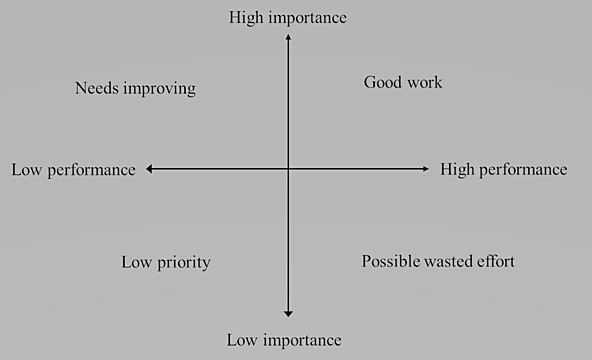When nothing else matters: Customer expectations

Successful brands focus on what is most important to their customers. The more a brand excels in these areas, the more success is expected. To maximise competitiveness, some argue that resources ought to be apportioned according to correlations with business outcome. The stronger the relationship, the more important. To prioritise those areas which are most deserving of investment, importance is compared against performance. There’s that scatterplot again, conceived and styled in the 1970s, it has not been reinvented since. Much like me to be fair.
Every area has one importance score and one performance score. The position of each area is plotted in relative space:

“See here! Invest in these things!” A laser pointer will encircle that top left-hand quadrant like a demented firefly. Here we find those areas of relatively lower performance and relatively higher importance. These quadrants are research’s preferred lens for most marketing decisions, from customer experience to product design and brand image. We include it wherever we can because we like its clear message: get higher scores on the things that matter the most.
Let’s put aside how irked we are that the quadrants are arbitrarily demarcated. Let’s forget that we sometimes get different results when we swap out top box percentages with average ratings. No matter. This is received wisdom, according to which the business will renew its strategy, ignoring the most critical factor of them all: customer expectation.
Expectation does more than attenuate importance; it warps linear relationships. We observe this happening slowly as markets mature, and rapidly, during periods of turmoil and innovation. As a result, scores that push preference up are not the same as those that push it down. To this, the linear scatterplot is blind. Wedded to its oversimplicity, businesses are directed to exceed already filled expectations, and underdeliver on what drives competitive advantage.
Enter Professor Noriaki Kano who called out this naive linear thinking, by distinguishing ‘must be’, ‘must not be’ and ‘attractive’ features. One could be forgiven for consigning his framework to new product development, for that’s exactly what we were told. Of course, it doesn’t need to be. These are merely descriptions of non-linear relationships. The idea has been repackaged several times; Kano included, building on what Hertzberg coined ‘hygiene factors’ and ‘motivators’.
If one is not hung up on terminology and prepared to substitute, Kano is made applicable to any research objective; a gift that keeps on giving. In this way, I’ve been dining out on Kano for a very long time – and you should too.
For what are ‘must be’ features, but any measure which rapidly improves preference as it is introduced and thereafter shows diminishing returns? What was originally a car without wheels can also be an untrusted brand, or what Van Westendorp termed ‘too cheap’ to be believed. It goes without saying, if a proposition fails to meet basic expectations, nothing else matters.
When these basic expectations go unmet, remaining features, specifically those that Kano termed ‘attractive’, don’t help at all. They are nice to haves, and can even backfire, adding insult to injury no matter how well intentioned. Think choccies on the pillow in a dirty hotel room, or champagne in the boot of a new car, one delivered two months later than promised. In this way luxury brands dissolve into obscurity. Despite retaining highly prized premium features, willingness to pay for them evaporates overnight.
Here, for example, aspects like great customer service are must haves, whereas even the limpest gesture from an economy brand is unexpected and if received, positively thrilling. That is to say, when expectations are met, ‘attractive’ features will skyrocket preference. They become differentiating delighters, the special sauce of world beating brands.
It also goes without saying that expectations vary by segment and brand. That is why competitive advantage is not meant for those who scatterplot their performance against the aggregate importance of their competitive set. In doing so, they drown out the importance of their own differentiators, and what their own customers expect of them. Their laser-assisted gesticulation orchestrates a perpetual game of catch-up.
In short, knowing what is most important is not as useful as knowing how it is important and to whom. Fortunately, there are many techniques capable of quantifying non-linear relationships – even a humble crosstab will do. Forty years after Kano’s introduction, this publication’s innovation award went to our learned colleagues at Yonder Consulting, for the very same. This time with the power of machine learning. This idea does not stale. It never goes out of fashion. It’s clearly more than academic nuance. No, this is fundamental marketing; a basic competency others expect of us, without which, nothing else matters.
Ryan Howard is a freelance data science consultant

We hope you enjoyed this article.
Research Live is published by MRS.
The Market Research Society (MRS) exists to promote and protect the research sector, showcasing how research delivers impact for businesses and government.
Members of MRS enjoy many benefits including tailoured policy guidance, discounts on training and conferences, and access to member-only content.
For example, there's an archive of winning case studies from over a decade of MRS Awards.
Find out more about the benefits of joining MRS here.














0 Comments